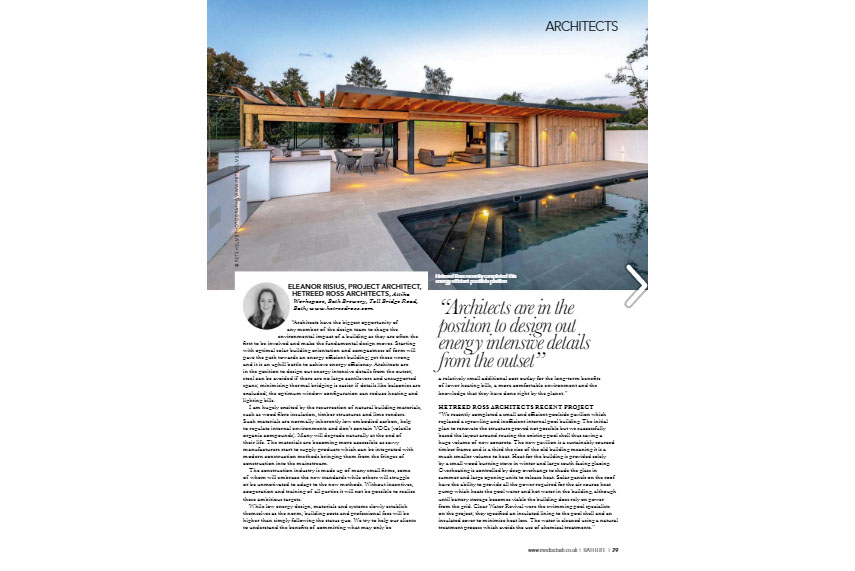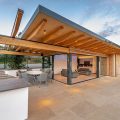Bath Life magazine: The eco-friendly future of construction
This months eco issue of Bath Life magazine includes answers from Eleanor Risius about the eco friendly future of construction.
Building construction has been seen as one of the culprits contributing to climate change. How is the industry reacting to help counter this?
Historically energy in use contributed the largest output of carbon emissions from a building. Voluntary and mandatory initiatives have been reducing this for many years. Passivhaus is a voluntary standard which sets high levels of air tightness and insulation to reduce heating demands to virtually nothing. Part L, the part of the Building Regulations which set the standards for energy efficiency, is becoming ever more rigorous and new revisions are in the pipeline for 2025 which will make this type of standard obligatory for new buildings.
The industry is now waking up to the impact of the embodied carbon within buildings. The Inventory of Carbon and Energy which was developed at the University of Bath is a leading database designers can refer to to understand the impact of the materials they specify. Environmental Product Declarations are increasingly being added to product manufactures literature. Industry led proposals for a new Part Z to the Building Regulations which would legislate on embodied energy and schemes to enable construction firms to recycle waste are hugely exciting developments.
How are architects in particular complying to new building codes?
Architects have the biggest opportunity of any member of the design team to shape the environmental impact of a building as they are often the first to be involved and make the fundamental design moves. Starting with optimal solar building orientation and compactness of form will pave the path towards an energy efficient building; get these wrong and it is an uphill battle to achieve energy efficiency. Architects are in the position to design out energy intensive details from the outset; steel can be avoided if there are no large cantilevers and unsupported spans; minimising thermal bridging is easier if details like balconies are excluded; the optimum window configuration can reduce heating and lighting bills.
Any new methods in the pipeline you’re excited about?
It’s the opposite of new but I am hugely excited by the resurrection of natural building materials, such as wood fibre insulation, timber structures and lime renders. Such materials are normally inherently low embodied carbon, help to regulate internal environments and don’t contain are VOCs (volatile organic compounds). Many will degrade naturally at the end of their life. The materials are becoming more accessible as savvy manufactures start to supply products which can be integrated with modern construction methods bringing them from the fringes of construction into the mainstream.
What difficulties and contradictions are there in trying to build green?
The construction industry is made up of many small firms, some of whom will embrace the new standards, others who will struggle or be unmotivated to adapt to the new methods. Without incentives, cooperation and training of all parties it will not be possible to realise these ambitious targets.
While low energy design, materials and systems slowly establish themselves itself as the norm, building costs and professional fees will be higher than simply following the status quo. We try to help our clients to understand the benefits of committing what may only be a relatively small additional cost outlay for the long term benefits of lower heating bills, a more comfortable home environment and the knowledge that they have done right by the planet.
Around these same issues, how does renovation work compare with building new?
Replacing an inefficient home with a new building will take years, if ever, to ‘pay back’ the embodied energy required to demolish and build anew. In almost every case renovation will work out less energy intensive in the long run. Unfortunately the government tax system currently incentivises building new.
A full renovation can be expensive and very disruptive requiring internal or external insulation, new windows, air tightness measures and new heating systems – although the rewards are great for those who do. A full renovation of a property using the Enerphit standard can reduce energy in use to 75-90% of its previous requirements. For those who aren’t ready to embark on such a project ‘easy wins’ can often be made with the less intensive measures such as loft insulation, draft stripping existing doors or fitting thermostatic valves.
A further hurdle in Bath is many properties are listed, requiring Listed Building Consent for most alterations. The designer must be experienced both in energy upgrades and working with listed building to ensure the character and the way the building performs is preserved throughout the changes.
Any examples of projects you admire / have completed?
We recently completed a small and efficient poolside pavilion which replaced a sprawling and inefficient internal pool building. The initial plan to renovate the structure proved not possible but we successfully based the layout around reusing the existing pool shell thus saving a huge volume of new concrete. The new pavilion is a sustainably sourced timber frame and is a third the size of the old building meaning it is a much smaller volume to heat. Heat for the building is provided solely by a small wood burning stove in winter and large south facing glazing. Overheating is controlled by deep overhangs to shade the glass in summer and large opening units to release heat. PVs on the roof have the ability to provide all the power required for the ASHP which heats the pool water and hot water in the building, although until battery storage becomes viable the building does reply on power from the grid. Clear Water Revival were the swimming pool specialists on the project; they specified an insulated lining to the pool shell and an insulated cover to minimise heat loss. The water is cleaned using a natural treatment process which avoids the use of chemical treatments.
Read the full article in this months Bath Life





